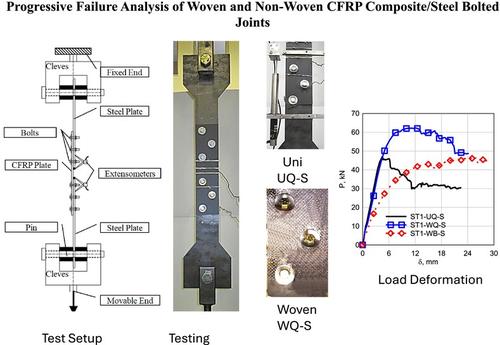Progressive failure analysis of woven and non-woven CFRP composite/steel bolted joints
IF 4.7
2区 材料科学
Q2 MATERIALS SCIENCE, COMPOSITES
引用次数: 0
Abstract
Due to recent advancements in textile fabrication, woven fabric reinforcements are used in composite structures as an alternative to traditional unidirectional fiber reinforcing layups. In this paper, experimental work was performed to study the behavior of multiple bolt-lapped joints under uniaxial tension. Different bolt numbers, composite layups, and fabric configurations were studied. Single- and double-lap configurations were used to investigate the effect of secondary stresses. It was found that the P-δ curves of lapped joints exhibit four primary stages: a linear elastic stage, followed by a nonlinear hardening stage, then linear hardening leading up to the peak, and finally a softening stage. For double-lapped non-woven joints, the curves encompass only the first three stages; however, for woven composites, the last stage is very small. In addition, among the laminates, the non-woven laminate sustains the highest normalized failure load, except in the staggered case, where the quasi-isotropic woven laminate exhibits higher strength. Conversely, the bidirectional woven laminate demonstrates the lowest loads and the highest deformation.

编织和非编织 CFRP 复合材料/钢螺栓连接的渐进失效分析
由于近年来纺织品制造技术的进步,复合材料结构中使用了编织物加固,以替代传统的单向纤维加固层。本文通过实验研究了单轴拉伸下多螺栓连接的行为。研究了不同的螺栓数量、复合层叠和织物配置。使用单搭接和双搭接配置来研究次应力的影响。研究发现,搭接接头的 P-δ 曲线表现出四个主要阶段:线性弹性阶段,随后是非线性硬化阶段,然后是达到峰值的线性硬化阶段,最后是软化阶段。对于双层无纺布接头,曲线只包括前三个阶段;但对于编织复合材料,最后一个阶段非常小。此外,在层压材料中,无纺布层压材料承受的归一化破坏载荷最高,但交错情况除外,在交错情况下,准各向同性编织层压材料的强度更高。相反,双向编织层压板承受的载荷最小,变形量最大。
本文章由计算机程序翻译,如有差异,请以英文原文为准。
求助全文
约1分钟内获得全文
求助全文
来源期刊

Polymer Composites
工程技术-材料科学:复合
CiteScore
7.50
自引率
32.70%
发文量
673
审稿时长
3.1 months
期刊介绍:
Polymer Composites is the engineering and scientific journal serving the fields of reinforced plastics and polymer composites including research, production, processing, and applications. PC brings you the details of developments in this rapidly expanding area of technology long before they are commercial realities.
 求助内容:
求助内容: 应助结果提醒方式:
应助结果提醒方式:


